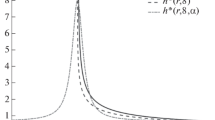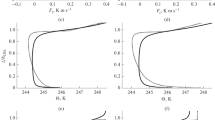Abstract
A time-dependent semi-geostrophic Ekman boundary-layer model based on the geostrophic momentum approximation is used to study the diurnal wind variation in the planetary boundary layer (PBL) and the evolution of the low-level nocturnal jet (LLJ). The coefficient of eddy viscosity varies periodically with time, varies linearly with height in the surface layer and is constant above the surface layer. The influence of horizontal advection of momentum on the diurnal wind variation in the PBL, the development of inertial oscillations (IOs) and the formation of the LLJ are examined.
In comparison with the Ekman solutions, the diurnal wind variation in semi-geostrophic Ekman boundary-layer dynamics has the following features: (1) the phase angle of the diurnal wind wave shifts with height, the rate of shifting is increased in anticyclonic regions and decreased in cyclonic regions, (2) the time of occurrence of the low-level maximum wind speed is later in anticyclonic regions and earlier in cyclonic regions, (3) the height of occurrence of the maximum wind speed is higher in the anticyclonic and lower in cyclonic regions, (4) the wind speed maximum and the amplitude of the diurnal wind variation are larger in anticyclonic and smaller in cyclonic regions, (5) the period of IOs is larger in anticyclonic regions and smaller in cyclonic regions, (6) anticyclonic vorticity is conducive to the generation of LLJ in the PBL. These features are interpreted by means of the physical properties of semi-geostrophic Ekman boundary-layer dynamics and inertial oscillation dynamics.
Similar content being viewed by others
References
Abramowitz, M. and Stegun, I. A.: 1965, Handbook of Mathematical Functions, Dover, 559 pp.
Blackadar A. K.: 1957, ‘Boundary Layer Wind Maxima and their Significance for the Growth of Nocturnal Inversion’, Bull. Amer. Meteorol. Soc., 38, 283-290.
Buajitti, K. and Blackadar A. K.: 1957, ‘Theoretical Studies of Diurnal Wind Structure Variations in the Planetary Boundary-Layer’, Quart. J. Roy. Meteorol. Soc. 83, 486-500.
Blumen, W. and Wu, R.: 1983, ‘Baroclinic Instability and Frontogenesis with Ekman Boundary Layer Dynamics Incorporating the Geostrophic Momentum Approximation’, J. Atmos. Sci. 40, 2630-2637.
Hoskins, B. J.: 1975, ‘The Geostrophic Momentum Approximation and the Semi-Geostrophic Equations’, J. Atmos. Sci. 32, 233-242.
Hoskins, B. J. and Bretherton, F. P.: 1972, ‘Atmospheric Frontogenesis Models: Mathematical Formulation and Solutions’, J. Atmos. Sci. 29, 11-37.
Krishna, K.: 1968, ‘A Numerical Study of the Diurnal Variation of Meteorological Parameters in the Planetary Boundary Layer’, Mon. Wea. Rev. 96, 269-276.
Levy, G.: 1989, ‘Surface Dynamics of Observed Maritime Fronts’, J. Atmos. Sci. 46, 1219-1232.
Mahrt, L.: 1975, ‘The Influence of Momentum Advections on a Well-mixed Layer’, Quart. J. Roy. Meteorol. Soc. 101, 1-11.
Mahrt, L.: 1981, ‘The Early Evening Boundary Layer Transition’, Quart. J. Roy. Meteorol. Soc. 107, 329-343.
Malcher J. and Kraus, H.: 1983, ‘Low-level Jet Phenomena Described by an Integrated Dynamical PBL Model’, Boundary-Layer Meteorol. 27, 327-343.
McNider, R. T., Moran M. D., and Pielke, R. A.: 1988, ‘Influence of Diurnal and Inertial Boundary-Layer Oscillations on Long-range Dispersion’, Atmos. Environ. 11, 2445-2462.
Ostdiek, V. and Blumen, W.: 1995, ‘Deformation Frontogenesis: Observation and Theory’, J. Atmos. Sci. 52, 1487-1500.
Paegle, Jan and Rasch, G.: 1973, ‘Three Dimensional Characteristics of Diurnally Varying Boundary-Layer Flows’, Mon. Wea, Rev. 101, 746-756.
Panchev, S.: 1985, Dynamic Meteorology, D. Reidel, 360 pp.
Panchev, S. and Spassova, T. S.: 1987, ‘A Barotropic Model of the Ekman Planetary Boundary Based on the Geostrophic Momentum Approximation’, Boundary-Layer Meteorol. 40, 339-347.
Pielke, R. A.: 1984, Mesoscale Meteorological Modeling, Academic Press, 612 pp.
Singh, M. P., McNider R. T., and Lin J. T.: 1993, ‘An Analytical Study of Diurnal Wind-Structure Variations in the Planetary Boundary-Layer and Low-Level Nocturnal Jet’, Boundary-Layer Meteorol. 63, 397-423.
Taylor, G. I.: 1915, ‘Eddy Motion in the Atmosphere’, Phil. Trans. Roy. Soc. London. A215, 1-26.
Thorpe, A. J. and Guymer, T. H.: 1977, ‘The Nocturnal Jet’, Quart. J. Roy. Meteorol. Soc. 103, 633-653.
Tory K. J. and Reeder, M. J.: 1996, ‘A Numerical Study of the Influence of a Diurnally Forced Planetary Boundary Layer on Dry Frontogenesis’, Preprints, 7th Conference on Mesoscale Processes, AMS, pp. 517-519.
Wipperman, F.: 1973, The Planetary Boundary Layer of the Atmosphere,Deutscher Wetterdienst, Offenbach, 346 pp.
Wu, R. and Blumen W.: 1982, ‘An Analysis of Ekman Boundary Layer Dynamics Incorporating the Geostrophic Momentum Approximation’, J. Atmos. Sci. 39, 1774-1782.
Author information
Authors and Affiliations
Rights and permissions
About this article
Cite this article
Tan, ZM., Farahani, M.M. An Analytical Study of the Diurnal Variations of Wind in a Semi-geostrophic Ekman Boundary Layer Model. Boundary-Layer Meteorology 86, 313–332 (1998). https://doi.org/10.1023/A:1000694732459
Issue Date:
DOI: https://doi.org/10.1023/A:1000694732459




